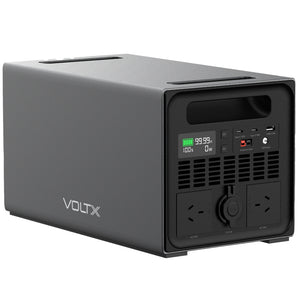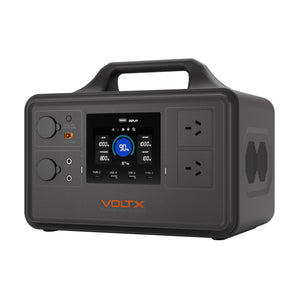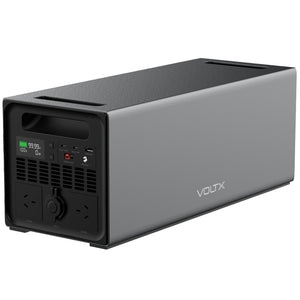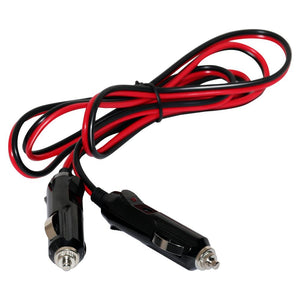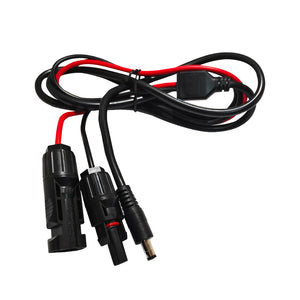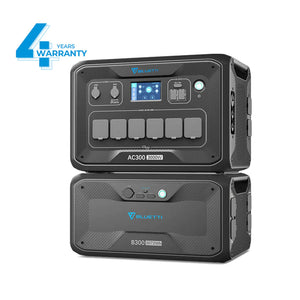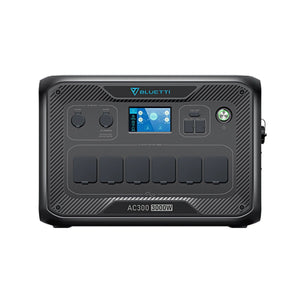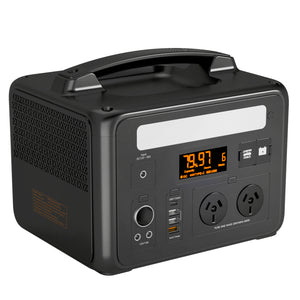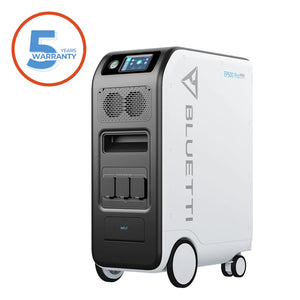Vehicle Car Cigarette Lighter Plug Socket Power Cable 1.5m
Was$19.90Now $14.93Unit price /UnavailableMC4 Connector Plug DC5521 Adapter Copper Core Wire Cable 1.5m
Was$19.90Now $14.93Unit price /UnavailableBluetti AC300 + B300 Home Battery Backup
Was$4,998.00Now $3,748.50Unit price /UnavailableVery low stockBluetti AC300 Inverter Module Generator 3000 (Must Work with B300)
Was$2,699.00Now $2,024.25Unit price /UnavailableBluetti AC500 Inverter Module Generator (B300S/B300 Required)
Was$3,399.00Now $2,549.25Unit price /UnavailableBluetti EP500Pro Solar Power Station
Was$6,299.00Now $4,724.25Unit price /UnavailableVery low stock
Your Essential Guide to Choosing and Using a Power Station
Ever found yourself stuck with a flat battery on a camping trip, or wishing for a bit of light and warmth during an unexpected power cut at home? Reliable, portable power can truly transform these moments. Modern portable power stations have emerged as versatile solutions that go far beyond traditional generators, offering clean, quiet, and convenient energy for outdoor adventures, home backup, and countless other applications.
Unlike their noisy, petrol-guzzling predecessors, today's power station technology combines LiFePO4 batteries with sophisticated electronics to deliver on-demand electricity wherever you need it. From keeping your devices charged during a weekend camping trip to ensuring essential appliances run during power outages, these portable power solutions have revolutionised how we think about off-grid power, making reliable electricity accessible virtually anywhere.
What Exactly Is a Modern Portable Power Station?
A portable power station is essentially a large, rechargeable battery pack equipped with multiple output types, including AC outlets, DC ports, and USB connections, designed to power everything from smartphones to small appliances. Unlike traditional fuel generators that rely on petrol or diesel engines, these battery generators operate silently without producing any fumes or emissions, making them safe for indoor use and ideal for noise-sensitive environments. At the heart of every quality power station is a high-capacity battery, most commonly the advanced Lithium Iron Phosphate (LiFePO4) type.
This is paired with an inverter that converts DC battery power to AC household current, a charge controller to manage incoming power from various sources, and an array of output ports to support different devices. Often referred to as a solar generator when paired with solar panels, these rechargeable generators represent a significant leap forward in portable power technology, offering clean, sustainable energy without the maintenance hassles of traditional generators.
Key Benefits: Why You Might Need One
The versatility of a modern power station extends far beyond simple convenience, offering tangible benefits across numerous scenarios where reliable electricity makes all the difference. For outdoor enthusiasts, a camping power station transforms the experience by powering campsite lights, keeping devices charged, running portable fridges, and supporting all the comforts that make adventures more enjoyable without sacrificing the connection to nature. At home, these units serve as invaluable emergency backup power during outages, keeping essential devices like CPAP machines operational, maintaining communication through charged phones, and ensuring basic lighting and small appliances continue functioning when the grid fails.
The eco-friendly power aspect particularly appeals to environmentally conscious users, as these units produce zero emissions during operation and, when charged via solar panels, offer completely renewable energy independence. Their silent operation makes them perfect for use in campgrounds with noise restrictions, residential areas during late-night power cuts, or any situation where the rumble of a traditional generator would be unwelcome. Whether you choose a compact unit like the VoltX E600 for light portable use or a more robust solution like the Outbax ACE M2000 for demanding applications, the peace of mind and versatility these units provide justify the investment for many users.
Choosing Your Ideal Power Station: Key Considerations
Selecting the best portable power station for your needs requires understanding several crucial factors that determine which unit will serve you most effectively, as the variety of options available can seem overwhelming without proper guidance.
Understanding Capacity (Watt-Hours, Wh) Explained
Battery capacity, measured in Watt-hours (Wh), represents the total amount of energy a power station can store and ultimately determines how long you can run your devices before needing to recharge. To put this in practical terms, a 300Wh station like the VoltX E600 (307Wh) could theoretically power a 30W camping light for approximately 10 hours, whilst a substantial unit like the Bluetti EP500Pro (5,100Wh, starting from $6,200) can run multiple high-demand appliances for extended periods. Understanding your power needs involves calculating the wattage of devices you plan to use and estimating runtime requirements—smaller capacities suffice for charging phones, tablets, and laptops, whilst larger capacities become essential when powering fridges, medical equipment, or multiple devices simultaneously during extended off-grid stays.
Power Output (Watts, W): What Can You Run?
While capacity tells you how long a power station can run, the power output measured in Watts (W) determines what appliances it can actually operate, with both rated (continuous) power and peak (surge) power being important specifications to consider. A 600W station like the VoltX E600 comfortably handles laptops, lights, and small electronics simultaneously,usly, whilst a powerstation 2,000 watt unit, such as the VoltX M2000 or ACE M2000, can manage more demanding applications, including small kitchen appliances, power tools, and multiple devices at once.
The Bluetti EP500Pro's impressive 3,000W rated power opens up possibilities for running virtually any household appliance short of high-demand items like electric ovens or air conditioners. Before purchasing, it's crucial to check the wattage requirements of your intended devices, remembering that some appliances require higher surge power during startup than their running wattage indicates.
Battery Technology: The LiFePO4 Advantage
The evolution of battery technology has dramatically improved the reliability and longevity of modern power stations, with Lithium Iron Phosphate (LiFePO4) emerging as the gold standard for portable lithium power applications. LiFePO4 power station units offer exceptional advantages, including significantly longer lifespans—often 2,000-4,000 charge cycles compared to 500-800 for traditional lithium-ion batteries—superior thermal stability that enhances safety, and better performance across temperature extremes.
Premium models like the VoltX Topband V1200 feature LiFePO4 battery cells rated for 2,000 cycles, whilst the Bluetti EP500Pro boasts an impressive 3,500+ battery life cycles, translating to years of reliable service even with daily use. This advanced chemistry's inherent safety characteristics, combined with its ability to maintain capacity over thousands of cycles, make it the preferred choice for users seeking long-term value and peace of mind.
Portability and Design: Weight, Size, and Handles
The physical characteristics of a power station significantly impact its usability, with weight and dimensions being crucial considerations that vary dramatically based on capacity and intended use. Lightweight LiFePO4 power station models like the VoltX E600 at just 7kg offer exceptional portability for hikers and casual campers who prioritise mobility, whilst more substantial units like the ACE M2000 (24.5kg) or the Bluetti EP500Pro (83kg) trade portability for dramatically increased power capacity. Design features such as ergonomic carry handles, robust casing materials (like the VoltX M2000's aluminium alloy shell), and thoughtful weight distribution become increasingly important as capacity increases, with some larger models incorporating wheels or telescoping handles to improve mobility despite their substantial weight.
Charging Options: Wall, Solar, Car
Modern power stations offer multiple charging methods to ensure you can replenish your mobile power station regardless of location, with each method offering different advantages and charging speeds. AC wall outlet charging typically delivers the fastest recharge times. Models like the VoltX Topband V1200 can reach a full charge in just 2 hours from mains power. Solar charging, on the other hand, offers a sustainable off-grid option via built-in MPPT controllers. However, it's generally slower and depends on factors like panel wattage and sunlight conditions. For example, the VoltX M2000 can achieve a full solar charge in about 3.5 to 4 hours under optimal conditions.
Car charging via 12V accessory sockets provides a convenient option during road trips, though generally at slower rates than wall charging, making it ideal for topping up rather than full recharges. The flexibility to combine charging methods, particularly the integration of advanced MPPT technology for efficient solar conversion, ensures these units remain versatile energy solutions regardless of your location or available power sources.
Powering Your Adventures: Top Picks for Camping and Caravans
For outdoor enthusiasts seeking the best portable power station for camping, the key lies in finding the perfect balance between capacity, portability, and features that enhance the outdoor experience whilst maintaining the tranquillity of natural settings. The VoltX E600 serves as an excellent entry point for basic camping needs, offering sufficient power for lights, device charging, and small electronics in a lightweight 7kg package, with the bonus of a jump starter feature that could prove invaluable in remote locations. Stepping up in capability, the VoltX Topband V1200 (starting from $999) represents a versatile middle ground at 13kg, providing enough capacity for extended weekend trips whilst remaining manageable for most users to transport, making it suitable for camping, caravanning, and 4WD adventures where moderate power needs must be met reliably.
For those embarking on longer expeditions or requiring power for more demanding devices like portable fridges and cooking appliances, the VoltX M2000 (starting from $1999) delivers an impressive 1,536Wh capacity with 2,000W output, striking an optimal balance for serious adventurers who need substantial power without completely sacrificing portability. The silent operation of these units proves particularly valuable in campgrounds and natural settings where the roar of traditional generators would disturb both wildlife and fellow campers, allowing you to enjoy modern conveniences without compromising the peaceful outdoor experience.
Reliable Energy for Your Home: Backup and Beyond
When considering a home backup power station or exploring off-grid solutions, the requirements shift towards higher capacity, greater output power, and features designed for seamless integration with household systems during emergencies or planned outages. During power cuts, these battery generators for home use ensure critical systems remain operational—from keeping lights on and medical devices like CPAP machines running to maintaining refrigeration and internet connectivity that's increasingly vital for remote work and emergency communications.
The ACE M2000 offers robust home backup capabilities with its 1,920Wh capacity and 2,000W output, sufficient for running essential appliances and maintaining basic comfort during shorter outages. For comprehensive home backup or semi-permanent off-grid installations, the Bluetti EP500Pro stands out with its massive 5,100Wh capacity, 3,000W continuous output, built-in UPS function for instantaneous switchover during outages, and an impressive 5-year warranty that reflects its design for long-term reliability. The expandable power station concept adds future-proofing to your investment, with models like the Bluetti AC200MAX or the VoltX E600 allowing additional battery connections to grow capacity as needs evolve, ensuring your emergency backup power system can adapt to changing requirements over time.
Harnessing the Sun: Solar Generators Explained
The integration of solar power compatibility transforms a standard power station into a complete solar generator system, offering true energy independence and the ability to maintain power indefinitely in sunny conditions without relying on grid electricity or fuel supplies. When paired with appropriate solar panels, these solar power stations leverage built-in MPPT (Maximum Power Point Tracking) controllers, a standard feature in quality units, to efficiently convert sunlight into stored electricity, maximising energy harvest even in variable light conditions.
The benefits of solar charging extend beyond mere convenience, encompassing reduced electricity costs over time, complete off-grid capability for remote locations or extended adventures, and the satisfaction of using genuinely renewable energy for your power needs. Choosing suitable solar panels involves balancing wattage output with portability requirements, as higher wattage panels charge faster but typically weigh more and require more setup space. Some manufacturers simplify the process by offering complete solar generator kits, such as the Bluetti AC500 + B300S Solar Generator Kit, which includes matched components optimised to work together efficiently.
Understanding Power Stations vs Traditional Generators
The distinction between modern battery-powered units and traditional Outbax generator models represents a fundamental shift in portable power technology, addressing the confusion some users experience when searching for silent generator alternatives. Power stations operate on completely different principles than conventional generators—using stored battery power converted through inverters, rather than burning petrol or diesel fuel in combustion engines, resulting in dramatically different user experiences and capabilities.
The advantages of power stations become clear through direct comparison: zero noise beyond quiet cooling fans versus the constant engine rumble of generators; no exhaust fumes or emissions making them safe for indoor use versus outdoor-only operation requirements; minimal maintenance beyond occasional cleaning versus regular oil changes, spark plug replacements, and fuel system maintenance; and instant, push-button operation versus pull-start mechanisms and warm-up periods. Whilst traditional generators still hold advantages in continuous runtime (as long as fuel is available) and lower cost per watt for very high power outputs, portable power stations have effectively replaced them for most residential backup and recreational applications where their clean, quiet operation and ease of use prove more valuable than raw power output or unlimited runtime.
Getting the Most From Your Investment: Tips and Care
Maximising the lifespan and performance of your power station requires understanding basic battery management principles and following manufacturer guidelines, as proper care can significantly extend the useful life of your investment. Battery cycle life optimisation involves avoiding complete discharge whenever possible, storing units at 50-80% charge during extended periods of non-use, and operating within recommended temperature ranges to prevent premature capacity loss.
Modern units incorporate sophisticated Built-in Battery Management Systems (BMS) that protect against overcharge, over-discharge, temperature extremes, and short circuits, but users should still follow basic safety practices including using only approved chargers and accessories, avoiding exposure to moisture, and ensuring adequate ventilation during operation. Understanding your unit's smart LED screen or display system helps monitor battery health, track power consumption, and identify any issues before they become serious problems. Regular maintenance is minimal but important—keeping ports clean and covered when not in use, checking connections for corrosion, and updating firmware when manufacturers provide updates ensures optimal performance throughout the unit's lifespan.
Final Thoughts on Energising Your Life
The evolution of portable power station technology has created unprecedented freedom and flexibility in how we access electricity, whether that's maintaining creature comforts during outdoor adventures, ensuring security during power outages, or enabling truly off-grid living. From the compact VoltX E600, perfect for weekend camping trips, to the substantial Bluetti EP500Pro capable of powering essential home systems for days, today's market offers reliable power solutions for virtually every need and budget.
The shift towards cleaner, quieter, more sustainable energy storage represents more than just technological progress—it's about enhancing life's experiences without compromise, knowing that dependable power is always within reach. As you consider your own power needs, remember that the right portable power station isn't just about specifications and features; it's about choosing a companion that enables your lifestyle, provides peace of mind during uncertainties, and opens new possibilities for adventure and independence in our increasingly connected world.
Frequently Asked Questions
- What is a portable power station?
- What size power station do I need?
- Is an Outbax power station the same as an Outbax generator?
- What's the difference between Wh (Watt-hours) and W (Watts)?
- What is an Outbax portable power station, and what can I use it for in Australia?
- How do I select the correct size Outbax power station for my Aussie adventures?
- Can Outbax power stations be charged using solar panels, which are ideal for off-grid trips?
- What safety features are included in Outbax power stations for peace of mind?
- What makes Outbax power stations a good choice for Australian conditions?
- How do I connect a solar panel to my power station?
- What are the best power stations?
- Can I use a power station indoors?
- How long does a LiFePO4 battery in a power station last?
- Are portable power stations noisy?
- What devices can I run with a power station?
- How long does it take to recharge a power station?
- Can I use a power station while it's charging?


